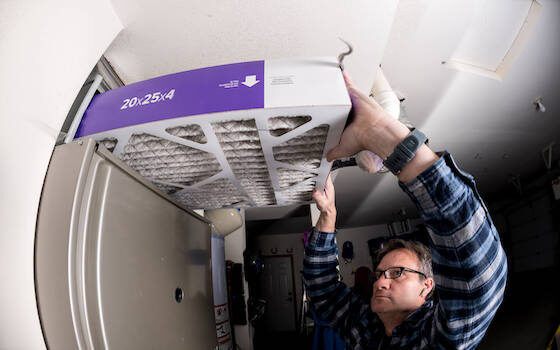Where is my Furnace? How to Locate your Central Heating
How to locate your furnace
Where is my Furnace? Typically, your furnace is centrally located in the home. You can usually find it in an area such as a utility closet (by a cold air return), a garage, an attic, basement, or crawlspace.
Air circulation in your home
If you have central heating, the furnace (also known as an air handler) in your home will heat your air in the winter while the blower motor circulates the air throughout your home. The AC evaporator coils for your air handler remove heat and humidity in summer. After your furnace heats or cools your air, it is then supplied to the duct system and the air begins flowing through your registers.
How many air systems run in your home?
Your thermostat is what sets the temperature in your home for your comfort. The number of thermostat(s) determine how many systems work to regulate your indoor air for heating and cooling.
Improve IAQ with Duct cleaning
Air duct cleaning can help reduce allergies from dust and other pollutants. Pollen, dust, and mold spores can get trapped in your duct work, which means that it’s being continuously circulated throughout the air you breathe at home.
According to the U.S. Department of Energy (DOE), 25 to 40 percent of the energy used for heating or cooling a home is wasted. Contaminants in the heating and cooling system cause it to work harder and shorten the life of your system. Although filters are used, the heating and cooling system still gets dirty through normal use.
The National Air Duct Cleaners Association (NADCA) recommends air duct cleaning for improvement of Indoor Air Quality (IAQ). A certified duct cleaning will include cleaning of the furnace, the main trunk line [for air circulation] and all vents (including supplies and returns) each cleaned out individually.
Where is a furnace/air-handler typically located in a home?
Where is my Furnace? Typically your furnace is centrally located in the home. It is usually located in an area such as a utility closet (by a cold air return), garage, attic, basement, or crawlspace; in the case of a heat-pump (a dual-system) it will be located outside of the home. When your system is run with a heat pump, it is likely a typical duct cleaning will include cleaning of evaporator coils with full system cleanings. Your furnace is usually located by other mechanical equipment such as the hot water heater, a [permanently installed] central vacuum cleaner, or a water softener, if this equipment is installed in your home.
Call Amazon Air Duct Cleaning to schedule a duct cleaning
in your home or business @ 800-482-8224
NADCA advises cleaning of air duct system(s) every 4-7 years.

Dust mites are one of the biggest indoor allergen problems for families in Westchester County. These tiny bugs are so small you can’t see them without a microscope. They live in warm, humid spots and eat the dead skin cells we all shed naturally. What makes people sneeze and wheeze isn’t the mites themselves – it’s their droppings and body parts floating around in

Fall in New Jersey brings beautiful colors and crisp air that draws everyone outdoors. But for allergy sufferers in Ocean County, late August also signals the start of ragweed season – weeks of sneezing, watery eyes, and congestion that can make even the nicest autumn day miserable. What Is Ragweed and Why Does It Love Toms River? Ragweed is a common weed that

The morning breeze from Long Island Sound carries more than just ocean air through Stamford’s neighborhoods. That salty scent signals trouble for your home’s air conditioning system. Residents in waterfront areas like Shippan Point and Cove Island experience this daily, but many don’t realize how coastal air damages their AC equipment. Salt particles in the air create a corrosive environment that speeds up metal

Spring pollen season and unpredictable Bergen County weather don’t have to derail your family’s weekend plans. Paramus offers numerous indoor destinations perfect for creating lasting memories while avoiding seasonal allergens that can trigger sneezing, watery eyes, and breathing difficulties. These carefully selected venues provide engaging experiences for children and adults alike, giving families comfortable spaces to enjoy quality time together. 1. Westfield Garden

Business owners are always looking for investments that actually pay off. You upgrade equipment, invest in technology, but there’s one thing most people skip: commercial air duct cleaning. This service hits your bottom line in three ways – lower operating costs, better employee productivity, and happier customers. The Business Costs of Dirty Ducts You Never Considered Commercial buildings deal with air quality issues

Dust mites are one of the biggest indoor allergen problems for families in Westchester County. These tiny bugs are so small you can’t see them without a microscope. They live in warm, humid spots and eat the dead skin cells we all shed naturally. What makes people sneeze and wheeze isn’t the mites themselves – it’s their droppings and body parts floating around in

Fall in New Jersey brings beautiful colors and crisp air that draws everyone outdoors. But for allergy sufferers in Ocean County, late August also signals the start of ragweed season – weeks of sneezing, watery eyes, and congestion that can make even the nicest autumn day miserable. What Is Ragweed and Why Does It Love Toms River? Ragweed is a common weed that

The morning breeze from Long Island Sound carries more than just ocean air through Stamford’s neighborhoods. That salty scent signals trouble for your home’s air conditioning system. Residents in waterfront areas like Shippan Point and Cove Island experience this daily, but many don’t realize how coastal air damages their AC equipment. Salt particles in the air create a corrosive environment that speeds up metal

Spring pollen season and unpredictable Bergen County weather don’t have to derail your family’s weekend plans. Paramus offers numerous indoor destinations perfect for creating lasting memories while avoiding seasonal allergens that can trigger sneezing, watery eyes, and breathing difficulties. These carefully selected venues provide engaging experiences for children and adults alike, giving families comfortable spaces to enjoy quality time together. 1. Westfield Garden

